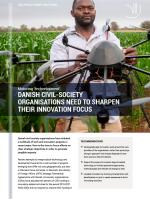Danish civil-society organisations need to sharpen their innovation focus
Danish civil-society organisations have initiated a multitude of tech and innovation projects in recent years. Now is the time to focus efforts on clear strategic objectives in order to generate tangible impacts.
■ Strategically align innovation work around the core priorities of the organisation, rather than pursuing a shotgun approach that chases disparate innovations across a field of interests.
■ Expand the scope of innovation beyond radical technology to include operational approaches, methodologies and theories of change as well.
■ Localize innovation by involving local partners and beneficiaries not just in needs assessments but in innovating solutions.
Recent attempts to merge radical technology and development have led to a vast number of projects emerging that differ not only geographically, but also in thematic focus and scale. In Denmark, the Ministry of Foreign Affairs’ (MFA) Strategic Partnership Agreements with Danish civil-society organisations (CSOs) have allocated ten percent of CSO funding to innovation-related activities for the period 2018-2021. While CSOs are not required to channel their funding inthis direction, this initiative suggests a shift in the MFA’s priorities, and it certainly indicates an innovation-first approach in the long-term trajectory of Danish development efforts both at home and abroad. A recent evaluation commissioned by the MFA assessed the innovation activities of sixteen Danish CSOs that have taken steps towards formalising their institutional capacities for innovation. Almost all of them have hired new innovation officers and teams, as well as developing strategies and tools for enacting innovation activities in their respective projects.
While these organisational changes signal a long-term commitment to innovation, they have had little immediate impact on project outcomes or impact measurements. This is due in part to the recency of the initiative, but more generally it is also a consequence of widespread experimentation with technologies and innovation methods that do not reflect CSOs’ primary capacities. Put differently, many CSOs have been insufficiently strategic in aligning their innovation work with their core organisational and thematic priorities. Instead, many have pursued a shotgun approach that has seen them initiate disparate projects, sometimes far removed from their respective capacities and comparative advantages. Now the honeymoon period of ‘techsploration’ is over. To make progress in innovating their development and humanitarian efforts, Danish CSOs need to take three steps.
Specialize
Danish CSOs need to align their innovation work strategically around the core priorities of their respective organisations.
Today we are witnessing the emergence not just of new technologies, but also of a growing specialisation of skills into such categories as FinTech, CleanTech, HealthTech, MedTech, CloudTech, GovTech and many others. This specialisation allows actors to focus on their core competencies and thus generate deeper and more measurable impacts.
Not only should CSOs be specialising by establishing innovation teams and creating a culture of innovation, they should also be working towards innovation projects that directly benefit their primary objectives as organisations. If a CSO focuses on providing support to refugees, it should seek out innovative solutions that do exactly that. Experimenting with how blockchain can streamline financial inclusion with the sole purpose of gathering experience with innovation and technology does not support the CSO’s primary goals.
There is a dire need to ensure that innovations in the sector not only reflect local needs, but build upon and develop local perceptions, competencies and skills.
In addition to these outcome-oriented concerns, CSOs often have limited funding. Just as with start-ups, providing demonstrable results in innovation projects could improve the flow of money to their operations, consequently ensuring greater impact on the communities served by their projects. If measurable results do not emerge, over time this innovation funding may be redirected to other, more impactful methods.
Move beyond tech
Importantly, innovation is not just about engaging with new, exponential or hyped technologies in the field: it is just as much about asking questions regarding the operational practices, strategies and norms that dominate an organisation’s work and thinking. CSOs should accordingly expand the scope of innovation practices beyond radical technological experimentation to further innovate operational approaches, methodologies and theories of change. While maintaining a focus on the organisational priorities, CSO innovation may also seek to spark new relationships with actors from the public or private sector, but it is also crucial to ask fundamentalquestions such as what are we specifically aiming to achieve, and what are the ways to achieve those ambitions we are not currently working towards? New relationships and understandings of how to drive change lend themselves to new programme strategies and solutions.
Certainly, Danish CSOs may be gearing up to make changes to the way they deliver services and carry out innovation activities, as the MFA evaluation demonstrated. For now, this has included hiring tech and innovation experts who are in a better position to help guide tech-driven solutions to programme issues. Moreover, the report speaks of the goal of some, though only a few, CSOs being to employ an ‘integrated’ approach, that is, an approach that integrates innovation at all levels of the organisation’s processes. This often relates to creating a greater ‘ecosystem’ for innovation, one in which all actors—especially local actors—are engaged in the negotiation of innovation activities.
Forming dedicated innovation teams evokes the decades-old discussion of how best to address what is essentially a cross-cutting issue – whether to attempt to streamline it across programmes and strategies or to build a separate team that can champion the case. The answer is likely to be a combination in which innovation expertise residing in a specific team can be employed in the different programmes and make a difference in existing work.

Localize innovation
Though representing novel approaches and techniques, innovation’s radical solutions need to maintain a high degree of relevance to the CSO mission. Just as innovation work needs to be specialised and focused, so too the process of innovation needs to be approached in such a way that the likelihood of impactful outcomes is maximised. Proposed solutions need to be relevant, effective and sustainable – all too often we see instances in which they are not.
One of the main obstacles in this regard is distance, and not just spatial distance, but cultural, professional and practical distance. Often the distance between partners means that innovations are developed in the global North and brought to local contexts based on perceived needs, but without involving target groups because local competencies are regarded as limiting contributions to the innovation process. Rarely do such approaches work well. There is a dire need to ensure that innovations in the sector not only reflect local needs, but build upon and develop local perceptions, competencies and skills.
That means linking local needs and solutions with global ones in ways that foster indigenous innovation, that is, moving from isolated top-down projects to solutions that are both locally sustainable and capable of being scaled. Whether we call it human-centred design or indigenous or participatory innovation, the aim is to put local systems at the heart of the innovation process. This is a key ingredient in making sure that innovations are not just suitable in the locations where they are intended to induce change, but that they are sustainable and will not quickly be rendered irrelevant.
Innovation and new technologies provide considerable promise for the future of development. However, thus far we have seen much exploration but few concrete results in the innovation projects of Danish CSOs. There is a need to align innovation projects and methods with the core competencies and priorities of the CSO to ensure deep programmatic impact and thus results for the beneficiaries. Given the great need for progress in circumstances of scarce operational resources, CSOs must shift their innovation gears from exploratory to strategic, thus narrowing their scope for innovative practices while increasing their potential for tangible impact.
DIIS Experts



